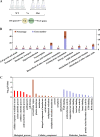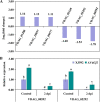Transcription Factor VdCf2 Regulates Growth, Pathogenicity, and the Expression of a Putative Secondary Metabolism Gene Cluster in Verticillium dahliae
- PMID: 36342142
- PMCID: PMC9680623
- DOI: 10.1128/aem.01385-22
Transcription Factor VdCf2 Regulates Growth, Pathogenicity, and the Expression of a Putative Secondary Metabolism Gene Cluster in Verticillium dahliae
Abstract
Transcription factors (TFs) bind to the promoters of target genes to regulate gene expression in response to different stimuli. The functions and regulatory mechanisms of transcription factors (TFs) in Verticillium dahliae are, however, still largely unclear. This study showed that a C2H2-type zinc finger TF, VdCf2 (V. dahliae chorion transcription factor 2), plays key roles in V. dahliae growth, melanin production, and virulence. Transcriptome sequencing analysis showed that VdCf2 was involved in the regulation of expression of genes encoding secreted proteins, pathogen-host interaction (PHI) homologs, TFs, and G protein-coupled receptors (GPCRs). Furthermore, VdCf2 positively regulated the expression of VdPevD1 (VDAG_02735), a previously reported virulence factor. VdCf2 thus regulates the expression of several pathogenicity-related genes that also contribute to virulence in V. dahliae. VdCf2 also inhibited the transcription of the Vd276-280 gene cluster and interacted with two members encoding proteins (VDAG_07276 and VDAG_07278) in the gene cluster. IMPORTANCE Verticillium dahliae is an important soilborne phytopathogen which can ruinously attack numerous host plants and cause significant economic losses. Transcription factors (TFs) were reported to be involved in various biological processes, such as hyphal growth and virulence of pathogenic fungi. However, the functions and regulatory mechanisms of TFs in V. dahliae remain largely unclear. In this study, we identified a new transcription factor, VdCf2 (V. dahliae chorion transcription factor 2), based on previous transcriptome data, which participates in growth, melanin production, and virulence of V. dahliae. We provide evidence that VdCf2 regulates the expression of the pathogenicity-related gene VdPevD1 (VDAG_02735) and Vd276-280 gene cluster. VdCf2 also interacts with VDAG_07276 and VDAG_07278 in this gene cluster based on a yeast two-hybrid and bimolecular fluorescence complementation assay. These results revealed the regulatory mechanisms of a pivotal pathogenicity-related transcription factor, VdCf2 in V. dahliae.
Keywords: VdCf2; Verticillium dahliae; gene cluster; pathogenicity; transcription factor; transcriptome.
Conflict of interest statement
The authors declare no conflict of interest.
Figures









Similar articles
-
Transcription factors containing both C2H2 and homeobox domains play different roles in Verticillium dahliae.mSphere. 2024 Sep 25;9(9):e0040924. doi: 10.1128/msphere.00409-24. Epub 2024 Aug 27. mSphere. 2024. PMID: 39189776 Free PMC article.
-
A Gene Cassette Vd276-280 in Verticillium dahliae Contains Two Genes that Affect Melanized Microsclerotium Formation and Virulence.Phytopathology. 2024 Dec;114(12):2515-2524. doi: 10.1094/PHYTO-11-23-0426-R. Epub 2024 Dec 6. Phytopathology. 2024. PMID: 39145683
-
The bZip Transcription Factor VdMRTF1 is a Negative Regulator of Melanin Biosynthesis and Virulence in Verticillium dahliae.Microbiol Spectr. 2022 Apr 27;10(2):e0258121. doi: 10.1128/spectrum.02581-21. Epub 2022 Apr 11. Microbiol Spectr. 2022. PMID: 35404080 Free PMC article.
-
Interactions between Verticillium dahliae and its host: vegetative growth, pathogenicity, plant immunity.Appl Microbiol Biotechnol. 2014 Aug;98(16):6921-32. doi: 10.1007/s00253-014-5863-8. Epub 2014 Jun 15. Appl Microbiol Biotechnol. 2014. PMID: 24928658 Review.
-
Transcription factor control of virulence in phytopathogenic fungi.Mol Plant Pathol. 2021 Jul;22(7):858-881. doi: 10.1111/mpp.13056. Epub 2021 May 11. Mol Plant Pathol. 2021. PMID: 33973705 Free PMC article. Review.
Cited by
-
Genomic insights into Verticillium: a review of progress in the genomics era.Front Microbiol. 2024 Oct 11;15:1463779. doi: 10.3389/fmicb.2024.1463779. eCollection 2024. Front Microbiol. 2024. PMID: 39464398 Free PMC article. Review.
-
T-DNAreader: fast and precise identification of T-DNA insertion sites in plant genomes using RNA sequencing data.Genome Biol. 2025 Jul 10;26(1):199. doi: 10.1186/s13059-025-03655-x. Genome Biol. 2025. PMID: 40640895 Free PMC article.
-
Transcription factors containing both C2H2 and homeobox domains play different roles in Verticillium dahliae.mSphere. 2024 Sep 25;9(9):e0040924. doi: 10.1128/msphere.00409-24. Epub 2024 Aug 27. mSphere. 2024. PMID: 39189776 Free PMC article.
-
Construction of Yeast One-Hybrid Library of Alternaria oxytropis and Screening of Transcription Factors Regulating swnK Gene Expression.J Fungi (Basel). 2023 Aug 3;9(8):822. doi: 10.3390/jof9080822. J Fungi (Basel). 2023. PMID: 37623593 Free PMC article.
-
Verticillium dahliae Secretory Aspartyl Protease VdSAP Targets Cotton GhARP to Modulate Plant Defence and Defoliation.Mol Plant Pathol. 2025 Apr;26(4):e70085. doi: 10.1111/mpp.70085. Mol Plant Pathol. 2025. PMID: 40251993 Free PMC article.
References
-
- Agrios GN. 1997. Plant pathology, 4th ed. Academic Press, San Diego, CA.
Publication types
MeSH terms
Substances
Supplementary concepts
LinkOut - more resources
Full Text Sources
Miscellaneous

